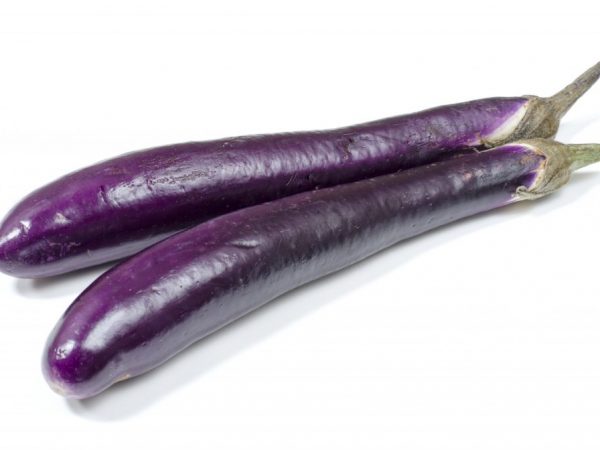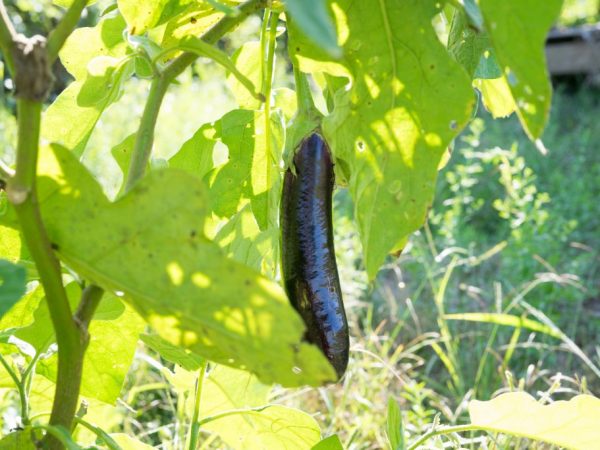Description of eggplant King of the North
The F1 eggplant King of the North is a new variety on the world market, but it has already gained popularity among gardeners. The variety is characterized by early ripening.

Description of eggplant King of the North
Variety characteristic
This variety is included in the State Register of the country. Despite the fact that the f1 category hybrid was bred for the cold regions of the country (Ural, Caucasus), it can be grown in all parts of Russia.
The growing season is 100 days from the moment of planting in open ground. The yield is excellent: about 8 kg of marketable products are harvested from 1 bush. The plant bears fruit throughout the summer.
Description of the bush
According to the description, the bush reaches a height of 1.2 m. The stem is purple. The leaves are large, broadly oval in shape. On their surface there is a dense layer of wax plaque. There are no thorns on the peduncle. Formation of 10-15 fruits is possible on each bush.
Description of the fetus
The description of the eggplant hybrid King of the North consists of the following characteristics:
- presented in the form of a cylinder;
- their surface is glossy, of a dark purple hue;
- fruit length can reach 30 cm;
- weight about 250 g;
Use and taste
Eggplant pulp King of the North f1 category has a creamy shade. The taste is specific, but pleasant. Since the pulp does not have any bitterness, you do not need to soak the eggplant pieces before cooking.
This variety is considered universal in terms of application. It can be used to prepare delicious main dishes or create unusual vegetable salads. Quite often it is canned for the winter.
Growing seedlings
It is recommended to plant the King of the North eggplant using the seedling method. This will allow you to reach peak fruiting much earlier and maximize your harvest.
Planting seeds for seedlings should be carried out in early February. For this, you can use separate cups so as not to damage the roots when picking. Before sowing, the seeds should be treated with a manganese solution (2 mg per 10 l of water). They should be soaked in such a solution for no more than 20 minutes, and then immediately rinsed under running water. If desired, treatment with growth stimulants can be carried out, which will speed up the moment of fruiting. It is necessary to deepen the seeds to obtain seedlings by 1.3 cm. After that, the containers are transferred to a heated room with an air temperature of 25 ° C. With the onset of germination, the temperature should be lowered to 18-20 ° C. After 30 days, when 4 leaves are formed on the plant, you can plant it in a permanent place.
It is best to plant seedlings at the end of May, when the soil has time to warm up after winter frosts. The planting scheme is 50x70 cm.The seedlings should be deepened by 3-5 cm.
Site preparation for planting

Preparing the soil in the fall
To grow an eggplant of the King of the North variety with ideal characteristics, you need to properly prepare the soil.The description of the variety indicates that the King of the North f1 eggplants need good lighting, so they need to be planted in areas where a lot of sunlight falls. In the fall, you should dig up the garden and remove the roots of all weeds from it. This will clear the soil of elements that take a lot of nutrients from it.
If the acidity level of the soil exceeds 6%, it is necessary to add lime to it while digging the garden. There should be about 4 kg of lime per 1 m2. In the spring, a month before planting, it is recommended to apply phosphate fertilizers to the soil, which will allow it to be nourished with the necessary useful trace elements that contribute to the better development of eggplants. Mullein or humus is an ideal fertilizer. For every 1 m2, at least 6 kg of fertilizer should be applied.
Care
Caring for the King of the North eggplant is simple.
- The watering interval should be 3-4 days. At this point, about 3 liters of water should be poured under each bush. It is recommended to use drip irrigation, which will provide the most effective soil moisture. You need to water the plants at a time when there is no direct sunlight. This will avoid root rot and crust formation. After watering, after 2 days, the soil should be loosened and all weeds removed.
- Top dressing is carried out several times. The first fertilization, which involves the use of organic matter, should be applied 20 days after planting. At this point, it is advisable to dilute 2 kg of humus or compost in 10 liters of water. 1.5 l of the preparation is poured under each plant. At the time of flowering, potassium fertilization can be carried out (30 mg of potassium nitrate per 10 liters of water). A few days before the start of fruiting, watering is carried out with phosphorus (50 mg per 10 liters of water).
- Due to the fact that the plant is quite large, you should regularly carry out a garter to the support. This will allow it not to deform if there is heavy rain or windy weather.
Diseases and pests
The main diseases to which this culture is exposed are powdery mildew and bacteriosis. You can fight powdery mildew by spraying with a tincture of Bordeaux liquid (4 mg per 5 liters of water). It is impossible to cure bacteriosis. It is necessary to remove the entire bush and burn it away from the garden.
Of the common pests, aphids and beetles should be distinguished. You can get rid of beetles with a solution of wood ash (20 g per 2 liters of water). With this solution, you need to wipe the entire bush. In the fight against aphids, spraying with Oxychom (30 mg of Oxychom per 8 liters of water) will help.
Conclusion
If you want to grow high quality products, then you must definitely follow the basic recommendations for planting and care. The yield is influenced by the origin of the variety and its genetic components, but still the result depends on the efforts of the gardener.


